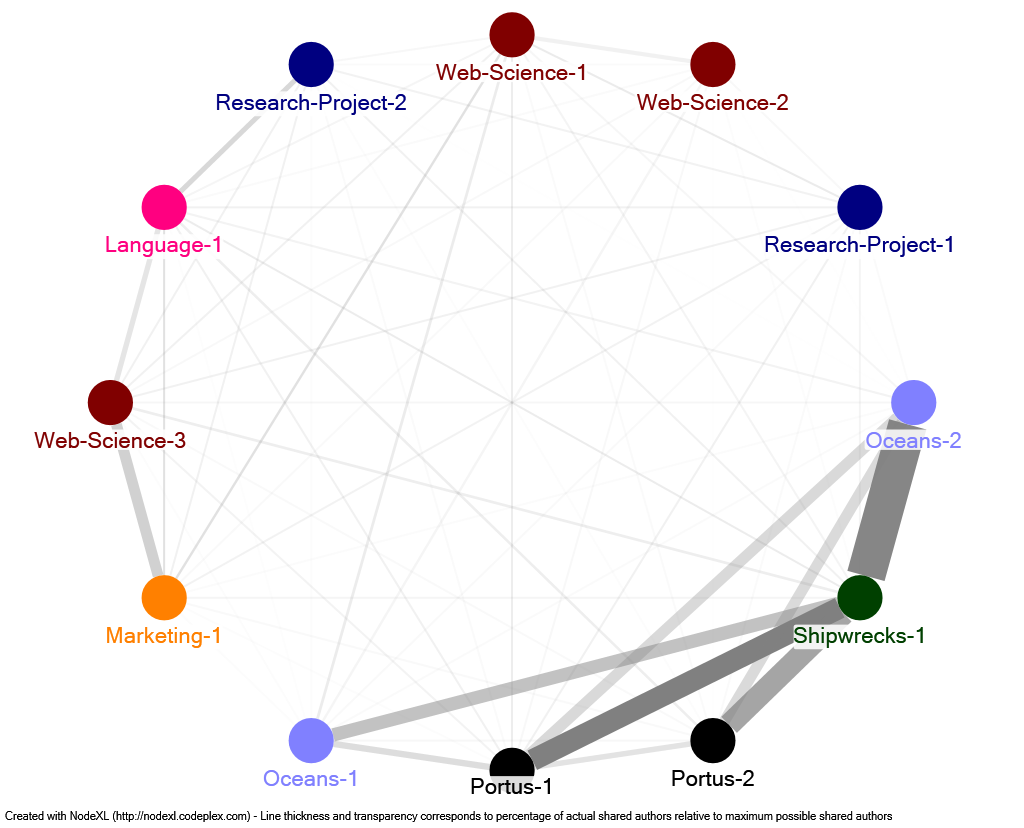FutureLearn social network: Portus in the UoS MOOCosphere

I have been looking at the comments from across all University of Southampton FutureLearn courses in an attempt to understand the place that the Archaeology of Portus learners fit within the wider community of learners on other University of Southampton FutureLearn courses.
As a first step I have aggregated the comments from all of the UoS courses that have run to date and then produced a simple network visualisation using the wonderfully easy to use NodeXL. The network diagram above shows connections between pairs of courses on the basis of a single learner having commented on both courses. I have excluded learner enrolement (i.e. learners who are enrolled on both courses but may not have commented on either) and concentrated on those learners who have posted comments. This will also allow me to look at the types of comments posted and the learner demographics in the hope that we can in turn improve courses better to reflect the needs of the UoS learner community. For example, what cross-references would it help to put in place (as we have with Hadrian’s Wall)? Should we provide specific advice or areas of further study based on potential previous courses?
The edge symbology in the network is based on a comparison between the number of unique authors posted on both courses in any pair, and the maximum possible unique authors who could have posted (in this case based on the lower of the two total numbers of learners who posted comments). I then scaled this percentage to match the symbology requirements of NodeXL with respect to line width and opacity.
The network shows a clear cluster of learners, not surprisingly, around the topics of maritime archaeology (Shipwrecks), the archaeology of ports (Portus, Rome, Ostia etc.) and Oceanography (Oceans). It is also interesting to note that the other courses are proportionally much less likely to share learners, including learners moving from one “run” of a course to another.
Drilling down into the statistics demonstrates that of those learners who have commented on more than one course, nearly a fifth had commented on at least three. Looking at the raw figures this is far more than one would expect were these members of the UoS teams. If you look at these learners in terms of the courses on which they are commenting Shipwrecks emerges again as the key bridging course. You can then go on to look at the behaviour of these learners in comparison to others. For example, we have already looked at the distribution of comments in terms of the proportion of liked comments or proportion of comments which are responses to others, as a coarse reflection of the kinds of behaviour seen on each course. Learners who have posted on three or more courses are considerably more likely to have their comment “liked” and so perhaps these learners are playing a role as intermediaries? This is supported by the fact that these learners are more than twice as likely to post a comment in response to a previous comment, than learners who are involved in only one or two courses.
We will certainly be using these simple analyses as part of the continuing design of the Archaeology of Portus course. For example, how can we harness this behaviour to encourage rapid spread of updated information?
As ever it is wonderful to be able to thank so many learners who are contributing their thoughts, suggestions (and criticisms!) so generously. Now that I have nearly completed a second run of Portus the power of analytics to improve learning is, not surprisingly, obvious.



